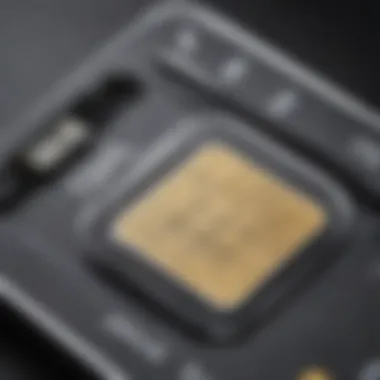Transferring Your Phone Number to a New SIM Card Explained


Intro
Transferring your phone number to a new SIM card can seem daunting, yet this process holds significant importance for many individuals. Whether you are switching carriers, upgrading your device, or simply seeking better service, understanding how to transfer your number is crucial. This guide breaks down each aspect of the transfer, ensuring you can take informed steps towards managing your mobile service without unnecessary hassle.
People transfer their numbers for various reasons. It may be due to dissatisfaction with their current provider, a move to a new location where coverage differs, or even cost considerations. By educating oneself on the intricacies of this transfer, one can greatly reduce potential frustrations.
The following sections will cover the technical procedures, possible challenges during the transfer, and several tips aimed at making the process as smooth as possible. Notably, taking the right steps can make all the difference in enjoying uninterrupted service.
This guide serves as a roadmap for both seasoned users and those new to mobile services.
Overview of Phone Number Transfer Process
Definition
The phone number transfer process involves shifting an existing phone number from one SIM card to another. This might occur during various scenarios such as changing mobile service providers or upgrading devices.
Key Features
- Number Portability: Users retain their original phone numbers during the transfer, which is essential for personal and business communications.
- Convenience: This transfer typically takes only a few minutes to a couple of hours, depending on the service providers involved.
- Cost Effectiveness: Many providers do not charge fees for number transfers, making it an economical choice.
Purpose and Benefits
The primary purpose of transferring a number is to create flexibility in choosing mobile services. Some benefits include:
- Better Coverage: Switching to a provider with more reliable coverage in a particular area.
- Lower Costs: Achieving savings on monthly bills by moving to a more affordable plan.
- Enhanced Features: Accessing features or plans that align better with personal or professional needs.
Understanding SIM Cards
The topic of SIM cards is fundamental to our discussion of transferring a phone number. Understanding SIM cards helps in grasping how mobile networks function and why switching to a new SIM card can be a necessary task.
What is a SIM Card?
A Subscriber Identity Module, commonly known as a SIM card, is a small plastic card that slots into mobile devices. This card contains an embedded microchip that stores data essential for connecting to mobile networks. The primary function of a SIM card is to identify the user on the network.
When you insert a SIM card into a phone, it allows the user to send and receive calls and texts, as well as access data services. Each SIM card is linked to a specific mobile number and carries information such as the International Mobile Subscriber Identity (IMSI) and encryption keys necessary for secure communication.
Understanding what a SIM card is can make the process of transferring your phone number much clearer. If you know how a SIM card works, you can better navigate the complexities of mobile services.
Types of SIM Cards
There are several types of SIM cards available, which vary in size and functionality. Below are the main kinds:
- Standard SIM: The original size of SIM cards. This format is less common now but may still be used in older devices.
- Micro SIM: Smaller than a standard SIM and used in many smartphones. It contains all the necessary functions of a SIM card but in a more compact form.
- Nano SIM: The smallest SIM size currently available. Most modern smartphones use Nano SIMs due to their size efficiency.
- eSIM: An embedded SIM that is built into the device. eSIMs are programmable and allow users to activate a mobile number without needing a physical card.
Each type serves a specific purpose, depending on the device and user needs. When transferring your number to a new SIM, knowing which type you need is crucial. A mismatch can lead to connectivity issues and hinder your mobile experience.
The Importance of Your Phone Number
Your phone number is more than just a series of digits. It is a crucial part of your identity in the digital age. Understanding its importance can enhance your choice when transferring to a new SIM card.
Why Transfer Your Number?
Transferring your phone number can seem like a small step, but it comes with several significant benefits.


- Continuity of Communication: Keeping the same number allows friends, family, and colleagues to reach you without needing to update their contacts. This ensures a seamless transition between service providers.
- Convenience: In a world where people often use their phones for business and personal communication, transferring your number saves you the hassle of notifying everyone about the change.
- Professional Representation: For professionals, changing a phone number can raise concerns among clients and business partners. Maintaining the same number reflects stability and consistency in your communication.
- Loyalty Benefits: Some carriers offer loyalty rewards or incentives for transferring a number to their service. This can provide additional value as you switch providers.
- Prevents Loss of Important Contacts: If your old number is tied to any accounts or services, you risk losing access to those if you change your number.
Common Scenarios for Transfer
Several situations prompt individuals to transfer their phone numbers:
- Switching Service Providers: Often, customers seek better plans or services from a different carrier. Retaining the existing number simplifies this process.
- Upgrading to a New Device: When moving to a new smartphone, you usually want to keep your established number. This ensures all apps and services tied to it remain functional.
- Traveling Abroad: If relocating temporarily or permanently to another country, transferring your number can sometimes facilitate better local service options while keeping your number intact.
- Merging Personal and Professional Numbers: As individuals navigate their careers, they may wish to consolidate numbers. A transfer allows for simplified communication channels without losing touch.
- Dealing with Unsatisfactory Service: If you find your current service provider inadequate, you can easily switch without the fear of losing your number.
Preliminary Considerations
Before initiating the transfer of your phone number to a new SIM card, it is essential to consider several factors that could influence the overall process. These preliminary considerations will save you time and help avoid potential issues. Understanding eligibility and contract obligations will ensure the transfer goes smoothly.
Eligibility for Number Transfer
Not all phone numbers are eligible for transfer to a new SIM card. Generally, the number must be registered in your name, and any outstanding balances with the current carrier should be resolved. Additionally, certain types of accounts, such as prepaid versus postpaid, may have specific regulations surrounding transfers. Check if your existing carrier allows number portability before proceeding. If the number is associated with a family plan, confirm with your carrier to see if transferring is permissible.
Common criteria for eligibility include:
- The phone number is currently active.
- The account is not in collections.
- There are no recent transfers for the same number within a specific period, dictated by regulations.
Contract and Fees
Understanding your current contract is vital. Many carriers enforce minimum contract periods, and early termination fees may apply if you try to transfer your number too soon. Review the terms of your contract to avoid unnecessary charges.
It is also important to note any fees associated with transferring your number. Some carriers may impose a transfer fee, while others may offer it at no cost as part of promotional offers. In addition, be aware of any potential costs from the new carrier when you sign up, which can include activation fees.
Key points to assess include:
- Current Contract: Are there any obligations or penalties?
- Transfer Fees: What costs are involved with both the current and new carrier?
- Incentives: Does the new carrier provide promotional advantages for switching?
Understanding these considerations can avoid confusion and allow a more seamless transition to a new SIM card.
Step-by-Step Process to Transfer Your Number
Transferring your phone number to a new SIM card involves several critical steps. Understanding this process is vital as it ensures a seamless transition without losing connectivity. The step-by-step approach offers clarity, enabling you to anticipate what is necessary and preparing you for any challenges that might arise.
Contact Your New Carrier
The first step in transferring your number is to have an open line of communication with your new carrier. This dialogue is crucial because the carrier must handle the transfer on their side. They provide specific guidance tailored to their procedures. Additionally, the carrier can clarify any requirements needed from you, making the process less daunting.
Provide Necessary Information
Account Number
The account number is pivotal when transferring your phone number. This number identifies your previous service account, making it easier for your new carrier to initiate the transfer. Providing the correct account number helps avoid delays and confusion. Typically, your account number is found on your billing statement or your online account portal. Ensuring accuracy here is beneficial, as a wrong account number can lead to complications in the transfer process.
PIN or Password
Your PIN or password acts as a security measure. It protects your account from unauthorized access during the transfer. This piece of information ensures that only you can authorize changes to your account. For this reason, it must be shared only with your new carrier during the transfer process. This contributes to the integrity of your mobile service and protects against potential fraud. It's common for mobile service providers to require this during any number transfer.
Billing Address
The billing address also plays a significant role in the transfer process. It serves as a verification point for the new carrier, confirming you are the account holder. The billing address must match what’s on file with the previous carrier. This precaution helps avoid any delays or disputes in the transfer process. Ensuring that your billing address is up to date with your previous carrier is advantageous.


Wait for the Transfer Process
After providing your new carrier with the necessary information, the next step is to be patient. The transfer process can take time, and there might be periods of uncertainty as the carriers communicate. Understanding that waiting is part of the process allows you to manage your expectations effectively. During this waiting period, it’s essential to ensure your old SIM card remains in use until you receive confirmation from the new carrier that the transfer is complete. This should prevent any inadvertent service interruptions.
What to Expect During the Transfer
Transferring your phone number to a new SIM card is a process that comes with certain expectations. Understanding these aspects can significantly ease any concerns you may have. The transfer largely involves two main elements: the duration of the transfer and the potential for temporary service disruption. Recognizing both these factors will help you plan better and minimize any inconveniences during this transition.
Duration of the Transfer
The duration of the transfer process can vary. Generally, a number transfer may take anywhere from a few minutes to several hours. On average, most transfers are completed within a single business day. The speed of your transfer often relies on factors like the policies of both your old and new service providers.
To ensure a smoother experience, consider the following:
- Time of Day: Transfers initiated during business hours tend to be processed more quickly.
- Service Provider: Some carriers are known for their expedited processes. It may be beneficial to inquire about this before switching.
- Type of Number: Understanding if your number is mobile or landline can also influence the time frame.
Keeping these points in mind can help you set realistic expectations.
Temporary Service Disruption
While transferring your number, it is common to experience temporary service disruption. This disruption can be unsettling, especially if you rely on your phone for communication. Typically, the disruption lasts only a few hours, but it can be longer in some cases.
To prepare for potential downtime, consider doing the following:
- Inform Your Contacts: Let important contacts know about the situation so they can reach you through alternative means if necessary.
- Plan Ahead: If you know you will need your phone for urgent matters, try to complete your transfer during a time when those responsibilities are minimized.
- Backup Important Information: Save essential data or contact information in advance to avoid losing anything critical during the transition.
It is crucial to remember that these temporary disruptions are often part of the process and do not indicate a failure of the number transfer itself.
Post-Transfer Steps
Post-transfer steps are crucial in ensuring that the transfer of your phone number has been successful and that you can maximize the utility of your new SIM card. Once the number porting process is complete, there are two significant actions to undertake: testing your new SIM card and updating your contacts and services. Each of these components plays a pivotal role in securing seamless communication and connectivity.
Testing Your New SIM Card
After transferring your phone number, the first thing to do is to test your new SIM card. This step is vital to confirm that everything works correctly following the transfer. You should begin by inserting the SIM card into your device. When the card is inserted, power on your phone and check for signal reception.
Once your device has fully booted, evaluate these aspects:
- Make a test call: Try calling a friend or a family member. Ensure that you can make outgoing calls successfully.
- Receive calls: Ask someone to call you. This checks that the new SIM card is operational both ways.
- Text messages: Send and receive SMS to confirm functionality.
- Data connectivity: Test your mobile data. Open a web page or an app that requires internet access to see if your data plan is linked appropriately.
If any issues arise during this testing phase, it may indicate a problem with the transfer. Common issues might include being unable to make or receive calls, or data services not functioning. In such cases, reach out to your new carrier’s customer service for assistance. It is essential to resolve these issues to ensure your communication lines are active without disruption.
Updating Your Contacts and Services
After confirming that your new SIM card works correctly, the next step is to update your contacts and any other services linked to your old phone number. This action helps ensure you maintain communication without interruption.
Start with your contacts:
- Inform friends and family: Let your close contacts know about the number change. This can prevent confusion.
- Update important contacts: For individuals who might not rely on social media or messaging apps for updates, a direct phone call or message may be necessary.
Next, consider services linked to your number:
- Email and messaging apps like WhatsApp, Signal, or Viber may require you to link your new number for verification. This is essential for maintaining uninterrupted access to these platforms.
- Banking and security services: Many banks and online services send verification texts to your mobile phone. Inform these services of your new number to avoid being locked out of your accounts.
- Social media accounts: Check platforms like Facebook or Instagram to ensure your profile reflects your current contact information. This will help others reach you easily.


By diligently following these post-transfer steps, you can ensure that your transition to a new SIM card is smooth and effective. Taking the time to verify your new SIM's functionality and update your contact information reinforces your connectivity and minimizes disruptions in your daily life.
Common Issues and Troubleshooting
Transferring your phone number to a new SIM card can present challenges. Understanding common issues enhances your ability to address them swiftly. This section provides insight into likely problems and effective troubleshooting methods. It empowers readers, allowing them to manage the transfer process more efficiently.
Failed Transfers
Failed transfers can create frustration. They typically occur due to incorrect information, account restrictions, or technical difficulties. One common cause is providing an incorrect account number or PIN when contacting your new carrier. It is important to double-check this information.
If your account is still under contract or has unpaid bills, it may prevent the transfer. It is crucial to clear up any pending matters before proceeding. Sometimes, carriers may face system outages; this can also affect the transfer. Understanding that these issues happen can reduce stress.
Here are steps to take if your transfer fails:
- Double-check your information: Ensure that the account number and PIN you provided are correct.
- Contact customer service: Reach out to your new carrier for assistance. They may provide insight into why the transfer did not succeed.
- Retry the process: If you have corrected your information, attempt the transfer again.
"Be proactive in resolving issues. Communication with carriers can clarify many uncertainties."
Maintaining Your Number's Integrity
Maintaining your number's integrity is essential. It involves ensuring that your number is recognized across all networks without discrepancies. When transferring numbers, problems can arise leading to confusion between your old and new services.
To avoid integrity issues, follow these recommendations:
- Keep your old service active until the transfer completes: This ensures that all calls and messages reach you.
- Confirm the transfer date: Know when the new SIM card becomes active. Changes can take hours or, in rare cases, days.
- Check your settings: Ensure your phone settings are updated to reflect the new network.
Another consideration is to monitor your service post-transfer. If you notice any missed calls or messages, act quickly. Addressing issues early can prevent ongoing complications.
Regulatory Considerations
When transferring a phone number to a new SIM card, regulatory considerations play a significant role. Understanding the legal landscape is crucial for users to navigate the process efficiently. It ensures that individuals recognize their rights and the protections available to them under consumer law. These factors can affect how smoothly the transfer will occur, making them essential to any discussion on this topic.
Understanding Your Rights
In many regions, consumers have specific rights when transferring their phone numbers. For instance, customers typically have the right to maintain their number, regardless of the carrier they choose. This principle, often referred to as number portability, is established to facilitate competition among service providers and empower consumers. Knowing these rights can support individuals in making informed decisions and can also provide leverage in disputes.
For example, if a service provider resists a number transfer without justification, the consumer can reference their rights to hold them accountable. Additionally, regulatory bodies, such as the Federal Communications Commission (FCC) in the United States, have guidelines that enforce these rights. This means that individuals can expect a level of service that adheres to legal standards. Be aware of local regulations, as they can vary widely by jurisdiction.
Consumer Protection Regulations
Consumer protection regulations are designed to safeguard individuals in various transactions, including phone number transfers. These laws are intended to prevent unfair practices and provide recourse in case of issues. For instance, if a consumer experiences frustration during the transfer, such as incorrect processing or failure to port the number, regulations allow for avenues of complaint and potential penalties for negligent carriers.
Highlighting the relevant protections:
- Transparency Requirements: Service providers must inform customers of the transfer process, potential fees, and time frames.
- Error Resolution Protocols: Carriers are obliged to have procedures in place for handling errors promptly.
- Recourse Mechanisms: Regulations might provide avenues for complaints, such as filing with a consumer protection agency.
Understanding these regulations helps consumers feel empowered. Awareness leads to informed choices and a smoother experience when switching providers. For further reading on consumer rights, you can visit Wikipedia.
“The best way to protect your rights is to know them.”
Closure
Transferring your phone number to a new SIM card is a practical decision that many individuals face. This article has emphasized the multiple elements involved in this process, from understanding SIM cards to dealing with potential issues that can arise during transfer. The importance of staying informed throughout this journey cannot be overstated. Knowledge of the nuances can save time and help in making the process smoother.
Summary of Key Points
- Understanding SIM Cards: Learning what a SIM card is and its various types lays the groundwork for understanding the transfer process.
- Importance of Your Phone Number: Knowing why one might transfer their number highlights the reasons for making this change.
- Preliminary Considerations: Checking for eligibility and understanding any potential fees are crucial steps before even starting the transfer.
- Step-by-Step Transfer Process: A clear outline of the steps involved aids in ensuring all necessary actions are taken in the right sequence.
- Transfer Expectations: Being aware of duration and potential service disruptions prepares individuals adequately.
- Post-Transfer Steps: Testing the SIM card and updating services ensure that everything functions as expected.
- Common Issues and Troubleshooting: Awareness of possible complications can aid in quick resolutions.
- Regulatory Considerations: Understanding consumer rights and protections informs individuals of safeguards in the process.
Final Thoughts on Number Portability
The capacity to transfer your phone number retains significant relevance in today's mobile landscape. Numerous reasons could necessitate this action, including better service options, cost-effectiveness, or a desire for enhanced features. As networks evolve, portability becomes essential in ensuring that consumers have continuity without losing their established contacts. A thorough understanding of how to approach this process means individuals can navigate it without undue stress. Remaining informed ultimately empowers users to maximize their mobile service experience.



